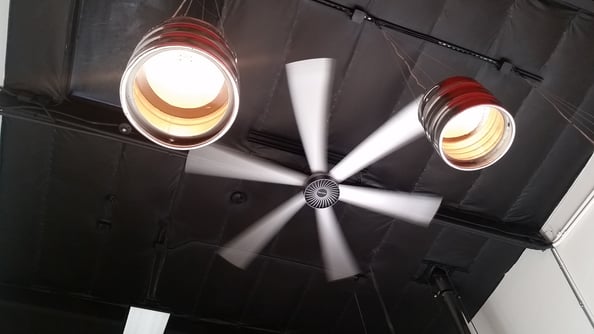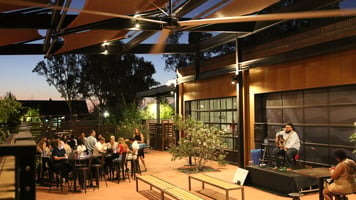Difference Between Indoor and Outdoor Ceiling Fans
You do not have to suffer through the heat on your patio, porch, or outdoor living area. There are both indoor and outdoor ceiling fans available, and oftentimes, they offer extreme versatility. Ceiling fans can be tough air-moving machines designed to withstand even the harshest of environments.
But let’s face it, identifying the right type of fan for your needs can be challenging! Do I need an indoor or outdoor fan? Is my space wet, dry, or damp? What type of material is the fan made of? What key features do I look for in my fan? Don’t feel overwhelmed! We are here to help! There are definite differences between indoor and outdoor ceiling fans. We are here to help decipher those differences, so you can make an informed decision. In this blog, we will discuss key differences between indoor and outdoor ceiling fans, including materials, performance, whether you need a wet-rated, damp-rated, or dry-rated fan, and cost. Read on to find out the differences you need to know to make an informed ceiling fan purchase.
Materials
.png?width=600&name=Email%20(1).png)
Indoor Ceiling Fan
Indoor ceiling fans are generally made of wood, particle board, vinyl, or plastic. These materials often are not cut out to be permanently exposed to outdoor elements. This includes prolonged exposure to extreme temperatures and wet or moist conditions. Blades made of wood or particle board can rot or mold due to moisture. Additionally, plastic and vinyl blades can warp due to heat and moisture exposure.
Any metal on an indoor ceiling fan is not specially treated to withstand the elements, either. So, any moisture will cause rust and corrosion. More importantly, the metals used can also be a major fire hazard. If the metal enclosure around the motor/power unit is not airtight (as is the case with most indoor ceiling fans), moisture can seep into the power unit and cause a short, which will cause an electrical fire. If not a fire, it will cause the fan to quit operating.
Outdoor Ceiling Fan
On the other hand, outdoor ceiling fans are made with exposure to extreme weather elements in mind. The metal enclosures on the motors are airtight and the blades are made with anodized finishes to keep them from rusting or corroding. They are outdoor rated to withstand damp and wet conditions. More specifics on that later.
MacroAir uses an anodized blade finish to ensure the blades are not only durable but also able to withstand temperatures without warping or to withstand moisture without rusting. As mentioned above, the power units are completely enclosed. This ensures that no moisture seeps into the unit, keeping it safe for you.
Performance

Indoor Ceiling Fan
Indoor ceiling fans are generally smaller in size than large outdoor ceiling fans. That is great to accommodate a smaller indoor space, as they do not need the extra ceiling clearance necessary to accommodate a larger outdoor fan. Indoor ceiling fans are often built to perform at a higher velocity. That means that the fans can quickly move air. This is great for directional airflow. You can feel the cool breeze easily when you are standing directly underneath the fans. But when you move further away from the fan, you will not feel as much air movement.
The motor unit and blades also influence ceiling fan performance. With residential fans, be sure to pay attention to the horsepower of your motor and the pitch of your blades. The steeper the pitch, the more airflow capacity. Likewise, the more powerful the motor, the better the airflow.
Outdoor Ceiling Fan
Outdoor ceiling fans are often bigger than indoor ceiling fans. MacroAir’s outdoor fans begin at 6 feet in diameter and go all the way up to 24 feet! That is a big fan, perfect for a larger space! The larger size is easily able to move a massive amount of air that can be felt throughout most outdoor spaces. In fact, large outdoor ceiling fans move about 13-40 times more air than a small indoor ceiling fan, depending on the size of the fan. Plus, they move the air in a slow and steady motion, which creates quiet and efficient airflow that everyone enjoys.
The motor units of an outdoor ceiling fan are built airtight, weather resistant, and to withstand tough conditions. Finishes, as mentioned above, are stronger than those of an indoor ceiling fan. MacroAir fans have airfoil blades. They are meant to move air in the most effective and efficient way possible. The shape of an airfoil blade moves the air around the blade in a way that does not interfere with the flow of air. Thus, you get the most effective air movement possible.
Wet/Damp/Dry Rated
.jpg?width=592&name=Crack%20Shack%201079%20(1).jpg)
1 - Dry-Rated
Dry-rated fans are designed for indoor areas only. These areas should not be exposed to moisture at all. When cleaning, you are able to dust off these fans but not hose them off. An ideal place for these would be in an office building, home living room or bedroom, or a retail space that is not exposed to moisture. You would not want to use a dry-rated fan in an outdoor patio, garage, shop, warehouse, or bathroom area.
2 - Wet-Rated
Wet-rated fans are designed to be used outdoors. They can tolerate exposure to all the elements. This includes the hot summer sun, the spring rain, and the winter snow. They are extremely durable fans. This is because they have fully enclosed, protected power units and weather-proof finishes. One of the other cool things about wet-rated fans is you can lightly hose them off when they need to be cleaned. An ideal place for these would be on an outdoor porch, under a pergola or gazebo, on a boat dock or boat garage, on an exposed deck, or on an oceanfront patio. Other ideal locations may be outdoor work areas, aquatic facilities, or any other commercial or industrial location where you are fully exposed to the elements.
3 - Damp-Rated
Damp-rated fans are designed for indoor and outdoor areas. But, here’s the difference between wet and damp…the outdoor areas must be areas where there will not be direct contact with water. Moisture and humidity, however, are okay and expected. As for cleaning, it is not recommended to hose the fan down, but instead to dust it off. Ideal places for damp-rated fans include covered patios, unfinished basements, screened-in porches, garages, shops, warehouses, commercial kitchens, restaurant patios or open-concepts, grow rooms, greenhouses, and/or areas with high humidity levels.
Cost

Outdoor ceiling fans cost a bit more than your average small indoor ceiling fan. You can expect to pay on average around $2,000-$6,000 for most outdoor residential ceiling fans. Even though the price of these fans is higher than your average indoor ceiling fan, keep in mind, outdoor ceiling fans are not the same thing. You are getting a much more durable fan that is extremely efficient and effective. The range in price is reflected in the quality of the product you are getting. Having said that, the cost of your fan is often offset by the money saved in operating costs. You can expect to run your fan for an average of $1 per day! Check out this complete outdoor ceiling fan buyer’s guide to help you know what to look for in an outdoor fan.
Find Your Ceiling Fan Today
.png?width=566&name=53%20(1).png)
Ceiling fans can be tough air-moving machines, but identifying the right type of fan for your needs can be challenging! We hope that this blog has given you some tools to help know the differences between indoor and outdoor ceiling fans. We are ceiling fan experts here to help you choose the right ceiling fan for you!
MacroAir Fans offers a variety of outdoor wet-rated ceiling fan options that work perfectly inside and outside. Our line of fans ranges in size from 6-24 feet in diameter. They are design-forward with a sleek look and feel! They also provide top-notch quality and performance at a very affordable price.
Contact one of our amazing and knowledgeable customer service representatives to assist you in finding the perfect outdoor ceiling fan for your space today.
https://macroairfans.com/contact/

